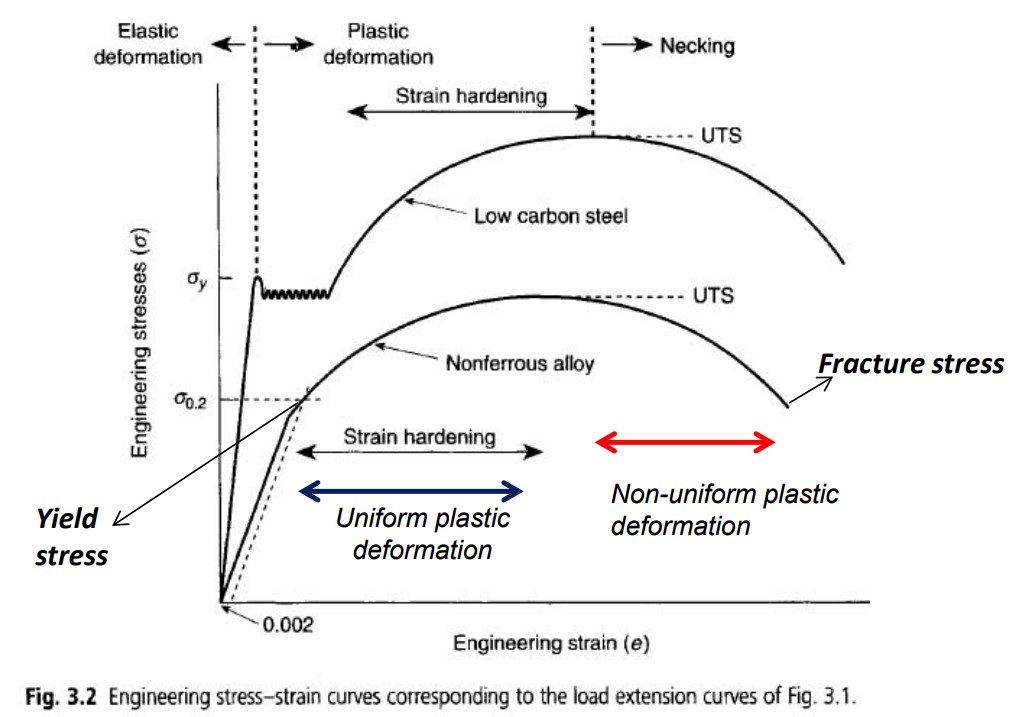mse midterm 2
5.0(4)
5.0(4)
Card Sorting
1/47
Earn XP
Description and Tags
Study Analytics
Name | Mastery | Learn | Test | Matching | Spaced |
|---|
No study sessions yet.
48 Terms
1
New cards
which one of the materials below has the highest electrical conductivity?
gold
polyethylene
polystyrene
gold
polyethylene
polystyrene
gold
2
New cards
which types of materials can be reshaped by heating?
thermosets or thermoplastics
thermosets or thermoplastics
thermoplastics
3
New cards
reducing the grain size in materials
increases/ decreases/ does not influence yield strength
increases/ decreases/ does not influence yield strength
increases
4
New cards
as cold work (%CW) is increased...
tensile strength does what?
tensile strength does what?
increases
5
New cards
poisson's ratio for the majority of materials lies within the following range
from -0.25 to 0.25
from 0.25 to 0.5
from -0.25 to 0.25
from 0.25 to 0.5
from 0.25 to 0.5
6
New cards
in the plot on the right, which materials has a higher ductility?
material 2 is more ductile than 1
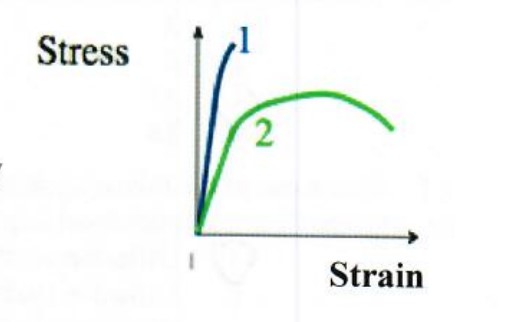
7
New cards
in the plot, which material has a higher yield strength?
material 1 has a higher yield strength
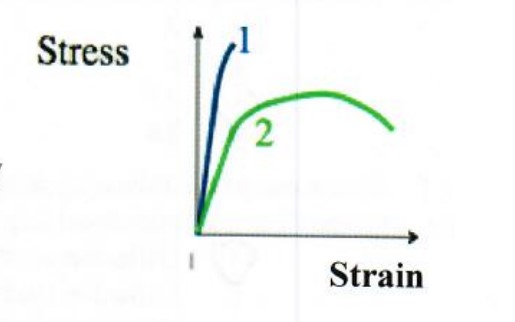
8
New cards
an amorphous polymer may behave like...
first, a glass at low temperatures, then, a rubbery solid at intermediate temperatures (above
the glass transition temperature), and as a viscous liquid at high temperatures
the glass transition temperature), and as a viscous liquid at high temperatures
9
New cards
which of the following correctly represents, for an amorphous polymer, a sequential change in mechanical state with increasing in temp?
a) rubbery solid, then transition to viscous liquid, then transition to glass
b) glass, then transition to rubbery solid, then transition to viscous liquid
c) rubbery solid, then transition to glass, then to viscous liquid
d) rubbery solid, then transition to viscous liquid
a) rubbery solid, then transition to viscous liquid, then transition to glass
b) glass, then transition to rubbery solid, then transition to viscous liquid
c) rubbery solid, then transition to glass, then to viscous liquid
d) rubbery solid, then transition to viscous liquid
b) glass, then transition to rubbery solid, then transition to viscous liquid
10
New cards
For a given material the tensile strength is 250 MPa and a yield strength is 150 MPa. You start applying tensile stress and gradually increase this applied value. At which value of the applied stress does the onset of necking occur?
500 MPa
250 MPa
150 MPa
300 MPa
500 MPa
250 MPa
150 MPa
300 MPa
250
11
New cards
The direction of motion of a screw dislocation's line is ____ to the direction of an applied shear stress
a) perpendicular
b) parallel
c) 45 degrees
a) perpendicular
b) parallel
c) 45 degrees
perpendicular
12
New cards
For a particular crystal structure, the slip plane is the plane having the
lowest or highest planar density
lowest or highest planar density
highest
13
New cards
You have Metal 1 with Young's modulus E1 and metal 2 with young's mod E2 = 2 * E1. You apply the same tensile stress to both metals. Assume that your deformation is elastic. the resulting tensile strain in metal 2 is...
the same
twice as large
twice as small
the same
twice as large
twice as small
twice as small than the strain in metal 1
14
New cards
Yield strength is defined as a stress at which noticeable plastic deformation with e= 0.002 has occurred.
true
false
true
false
true
15
New cards
Which of the following is a point defect in ceramics representing a cation vacancy-cation interstitial pair?
a) frenkel defect
b) schottky defect
c) edge dislocation
d) screw dislocation
a) frenkel defect
b) schottky defect
c) edge dislocation
d) screw dislocation
frenkel defect
16
New cards
Which of the following is a (are) ID defect(s)?
a) A Frenkel defect
b) A Schottky defect
c) An edge dislocation
d) A screw dislocation
a) A Frenkel defect
b) A Schottky defect
c) An edge dislocation
d) A screw dislocation
edge and screw
17
New cards
How many slip systems are there in FCC crystal structure?
3
4
12
16
3
4
12
16
12
18
New cards
Which one of the following statements is true. Take into account that the Nitrogen is an interstitial impurity in Fe, whereas Cr is a substitutional impurity
a) diffusion coefficient for N in Fe at 750 C is higher than for Cr in Fe at 750
b) diffusion coefficient for N in Fe at 750 C is lower than for Cr in Fe at 750
c) diffusion coefficient for N in Fe at 750 C is equal to that for Cr in Fe at 750
a) diffusion coefficient for N in Fe at 750 C is higher than for Cr in Fe at 750
b) diffusion coefficient for N in Fe at 750 C is lower than for Cr in Fe at 750
c) diffusion coefficient for N in Fe at 750 C is equal to that for Cr in Fe at 750
a) diffusion coefficient for N in Fe at 750 C is higher than for Cr in Fe at 750
19
New cards
Increasing activation energy Qd in expression for diffusion coefficient, D
increases/ decreases/ does not affect
increases/ decreases/ does not affect
decreases
20
New cards
You have a material A with the tensile strength 300 MPa, a material B with the tensile strength 200 MPa, and a Material C with the tensile strength 50 MPa. Which one of these materials most likely has a highest hardness?
material A or B or C
material A or B or C
A
21
New cards
For a given material the tensile strength is 200 MPa, and a yield strength is 100 MPa. You need to use this material with a factor of safety 2. What would be the maximum working tensile stress you can apply to this material
400 MPa
200 MPa
100 MPa
50 MPa
400 MPa
200 MPa
100 MPa
50 MPa
50 MPa
22
New cards
a) Draw a schematic of an engineering stress-engineering strain curves for Material A and Material B. Label both axes. You are given that Material A has a higher Young's modulus, higher tensile strength and a higher yield strength than material B. You also know that the material A is less ductile than the material B. On both curves, mark (1) tensile strength, (2) fracture point, (3) yield strength.
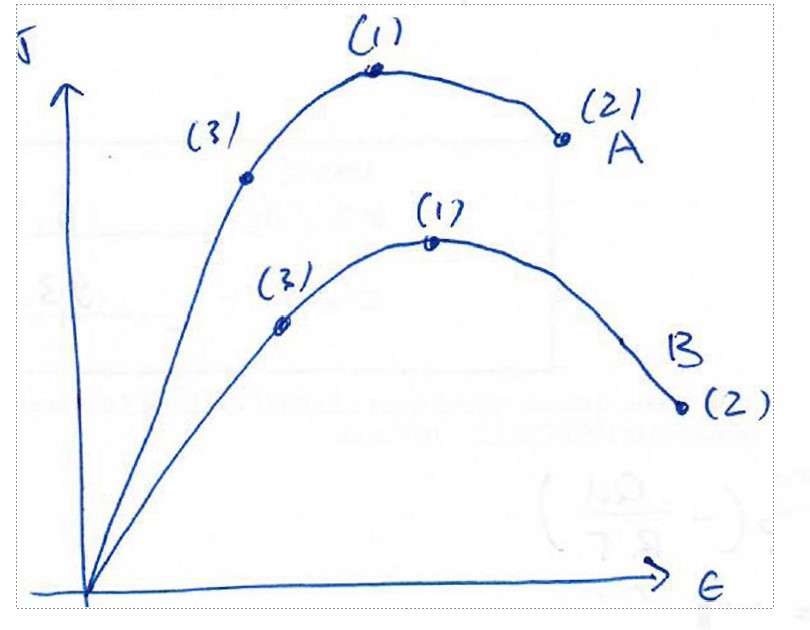
23
New cards
Which of the following is a (are) 1 D defect(s)?
a) A Frenkel defect
b) A Schottky defect
c) An edge dislocation
d) A screw dislocation
a) A Frenkel defect
b) A Schottky defect
c) An edge dislocation
d) A screw dislocation
c) An edge dislocation
d) A screw dislocation
d) A screw dislocation
24
New cards
How does each of the following influence the tensile modulus of a semicrystalline polymer
(a) molecular weight decrease
(b) degree of crystallinity increase
(c) deformation of drawing
(d) annealing of an undeformed material
(e) annealing of a drawn material
A) non-direct influence, increase, decrease, decrease, decrease
B) non-direct influence, increase, increase, increase, decrease
C) non-direct influence, increase, decrease, increase, decrease
D) increase, decrease, decrease, increase, decrease
(a) molecular weight decrease
(b) degree of crystallinity increase
(c) deformation of drawing
(d) annealing of an undeformed material
(e) annealing of a drawn material
A) non-direct influence, increase, decrease, decrease, decrease
B) non-direct influence, increase, increase, increase, decrease
C) non-direct influence, increase, decrease, increase, decrease
D) increase, decrease, decrease, increase, decrease
B) non-direct influence, increase, increase, increase, decrease
25
New cards
is it possible for three or more elements to form a solid solution?
yes
26
New cards
Does the grain-size number G increases or decreases with the decrease in the grain size
increase
27
New cards
which of the materials below has the highest electrical conductivity?
silver
silicon
polystyrene
silver
silicon
polystyrene
silver
28
New cards
Which of the materials below has the lowest electrical conductivity?
a) Polyethylene
(b) Iron
(c) Aluminum Oxide
(d) Silicon
a) Polyethylene
(b) Iron
(c) Aluminum Oxide
(d) Silicon
a) Polyethylene
29
New cards
For a screw dislocation, Burgers vector is perpendicular to the dislocation line
true or false
true or false
false
30
New cards
For an edge dislocation, Burgers vector is perpendicular to the dislocation line
true false
true false
true
31
New cards
Which one of the following statements is true?
(a) Adding Ni to Cu increases its conductivity
(b) Adding Ni to Cu decreases its conductivity
(c) Adding Ni to Cu does not affect its conductivity
(b) Adding Ni to Cu decreases its conductivity
(c) Adding Ni to Cu does not affect its conductivity
32
New cards
Which types of solid solutions do you know?
substitutional and interstitial
33
New cards
A cation vacancy-cation interstitial pair is called _____ defect
frenkel
34
New cards
A pair of cation and anion vacancies is called ______ defect
schottky
35
New cards
With the increase in temperature T, the vacancies concentration in metallic crystal structure
(a) increases
(b) decreases
(c) remains constant
(a) increases
(b) decreases
(c) remains constant
increases
36
New cards
With the increase in temperature T, the concentration of the Shottky defects in a ceramic material
increases/ decreases/ remains constant
increases/ decreases/ remains constant
increases
37
New cards
The image on the right shows the inter-atomic force as a function of separation for two metals. Which one of the following statements is true?
(a) the atoms are more strongly bonded in metal 1 than 2
(b) the atoms are more strongly bonded in metal 2 than 1
(a) the atoms are more strongly bonded in metal 1 than 2
(b) the atoms are more strongly bonded in metal 2 than 1
(b) the atoms are more strongly bonded in metal 2 than 1
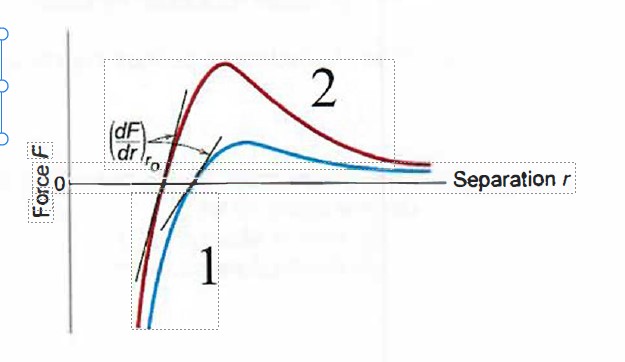
38
New cards
Which material from the list below has a lowest Young's modulus?
(a) Cu alloys
(b) Magnesium
(c) Graphite
(d) Polyester
(e) Carbon fibers
(f) Molybdenum
(a) Cu alloys
(b) Magnesium
(c) Graphite
(d) Polyester
(e) Carbon fibers
(f) Molybdenum
(d) Polyester
39
New cards
The σy marked on the plot on the right is called
tensile strength
yield strength
tensile stress
toughness
tensile strength
yield strength
tensile stress
toughness
yield strength
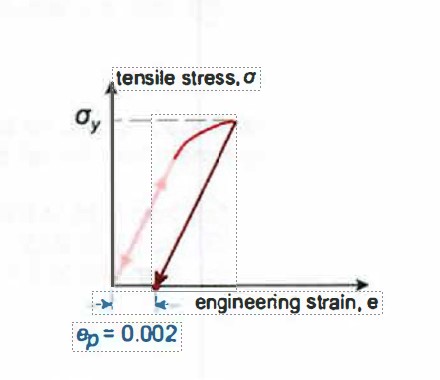
40
New cards
In the plot on the right, which material has a higher ductility?
material 1 is more ductile than 2
material 2 is more ductile than 1
material 1 is more ductile than 2
material 2 is more ductile than 1
material 2 is more ductile than 1
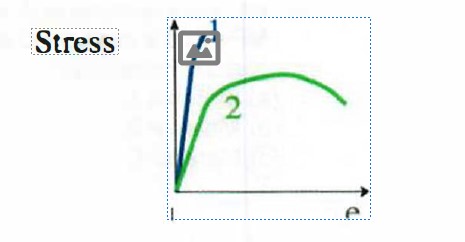
41
New cards
In the plot given, which material has a larger Young's modulus?
(a) Young's modulus of material 1 is larger than Young's modulus of material 2
(b) Young's modulus of material 2 is larger than Young's modulus of material 1
(a) Young's modulus of material 1 is larger than Young's modulus of material 2
(b) Young's modulus of material 2 is larger than Young's modulus of material 1
(a) Young's modulus of material 1 is larger than Young's modulus of material 2
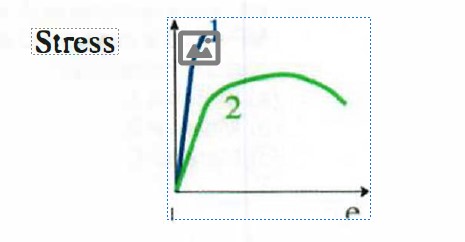
42
New cards
In the plot provided, which material has a larger toughness?
(a) material 1 has a larger toughness
(b) material 2 has a larger toughness
(a) material 1 has a larger toughness
(b) material 2 has a larger toughness
(b) material 2 has a larger toughness
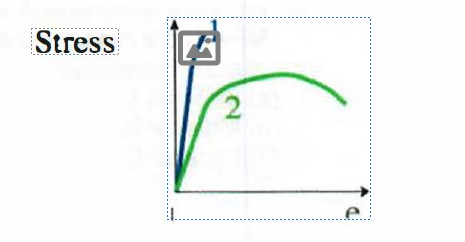
43
New cards
young's modulus is defined as
ratio of stress over strain
ratio of strain over stress
stress multiplied by strain
ratio of stress over strain
ratio of strain over stress
stress multiplied by strain
ratio of stress over strain
44
New cards
what characteristic defines the resistance to permanently indenting the surface of the material?
hardness
45
New cards
Poisson's ratio is defined as
(a)ratio of a tensile strain over a lateral strain
(b)ratio of a lateral strain over a tensile strain
(c)ratio of a tensile strain over a lateral strain multiplied by "-1"
(d)ratio of a lateral strain over a tensile strain multiplied by "-1"
(a)ratio of a tensile strain over a lateral strain
(b)ratio of a lateral strain over a tensile strain
(c)ratio of a tensile strain over a lateral strain multiplied by "-1"
(d)ratio of a lateral strain over a tensile strain multiplied by "-1"
(d)ratio of a lateral strain over a tensile strain multiplied by "-1"
46
New cards
Poisson's ratio for the majority of the materials lies within the following range (choose the correct statement from the list below)
(a) from 0.25 to 0.5
(b) from 0 to 0.25
(c) from -0.1 to 0.1
(a) from 0.25 to 0.5
(b) from 0 to 0.25
(c) from -0.1 to 0.1
(a) from 0.25 to 0.5
47
New cards
You have a material A with the tensile strength 100 MPa, a material B with the tensile strength 200 MPa, and a material C with the tensile strength 300 MPa. Which one of these materials most likely has a highest hardness?
Material C
48
New cards
engineering stress - strain plot
